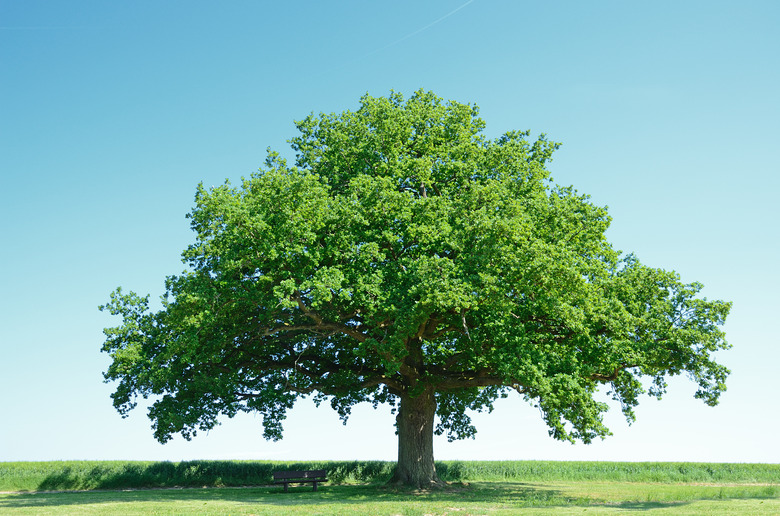How To Identify Oak Trees
With more than 600 species of oaks (Quercus spp.) located across North America, Europe, North Africa and Asia, identifying one particular species from another can be a challenging task. Although some species have wildly different leaves than other species, multiple trees in the same species have nearly identical leaves making identifying the trees based on leaf shape alone nearly impossible in many cases. One thing you can identify based on leaf shape is the leaf group, meaning whether the tree is a red or white oak. Other than that, you might need a regional guide to identify specific oak trees in your area based on the tree's leaves, location, acorns and other factors.
Leaf Shape
Leaf Shape
Although leaf shape alone is impossible to use to identify most species, the leaf is one of the most important factors in identification. Things to note include not only the shape and color of the leaf but the number of lobes on the leaves, whether it is serrated or smooth, the depth of the veins, whether it has hair on it and the arrangement of the leaves on the branch. If you are trying to identify an oak during winter or fall, you might also be able to identify whether the leaves change color and fall off or if the tree is an evergreen species.
It's worth noting that although leaf shape alone is rarely enough to identify a tree's species, there are a handful of oaks with very distinctive leaves that can accurately result in the identification of the tree with no other information. An example includes the endangered maple-leaved oak (Quercus acerifolia, USDA hardiness zones 5-8) of Western Arkansas that has deeply lobed leaves that resemble maple tree leaves more than they resemble most other American oak leaves.
Identifying Oak Groups
Identifying Oak Groups
One thing the leaf shape can help you identify is whether the oak is a red or white oak. Almost all oaks can be classified into one of these groups. For example, live oak (Quercus virginiana, zones 8-10), chinkapin oak (Quercus muehlenbergii, zones 3-7) and overcup oak (Quercus lyrata, zones 5-9) are all white oaks, whereas black oak (Quercus velutina, zones 3-9), pin oak (Quercus palustris, zones 4-8), and cherrybark oak (Quercus pagoda, zones 6-9) are all red oaks. While there are some exceptions, red oaks are overall identified by their pointed lobes and bristled tips, while white oak trees tend to have rounded lobes. As you might imagine, the wood and bark on red oaks are also darker than they are on white oaks.
Once you know whether a tree is a red or white oak, you can at least know a little bit more about its growth cycle. Red oaks take two years to reach maturity and produce acorns consistently year round. White oaks, on the other hand, take only one year to reach maturity and do not produce acorns consistently, sometimes dropping many in just a few months only to not drop any until the next year, when they will drop a much smaller amount scattered throughout the months.
Growth Range
Growth Range
Although there are sometimes very similar oaks growing within one region, this can sometimes be enough to identify an oak when looking at its leaves. For example, the only oak with heavily lobed leaves in the southern Rocky Mountains is the Gambel oak (Quercus gambelii, zones 4-9).
Sometimes you not only need to look at your location geographically but also the habitat. For example, if you are in America's South and see an oak with a leaf that looks like a duck foot, it will probably be a blackjack oak (Quercus marilandica, zones 6-9) if you are on a dry ridge. But if you are in a swampy forest area, it is likely a water oak (Quercus nigra, zones 4-9).
Acorn Details
Acorn Details
Although acorns are not always available to investigate depending on the season and the tree's maturity, they can be particularly helpful while trying to identify an oak tree. Things to look for when examining an acorn include the size, shape and color of both the nut and the cap. The bur oak (Quercus macrocarpa, zones 3-8), for example, is notable for having a fringe on its acorn cup.
Other Things to Look For
Other Things to Look For
Although leaves, location and acorns are some of the biggest giveaways, you may have to look at other factors as well. The width and height of the fully grown trees, hairs on the stems, flowers, buds, texture or color of the bark and the fullness of the foliage can all be useful in identifying an oak tree.
